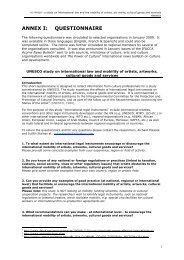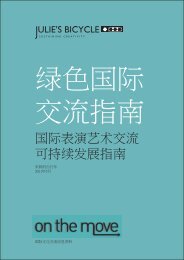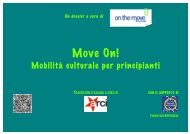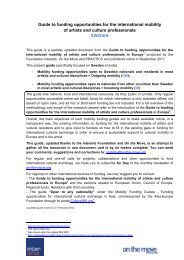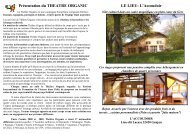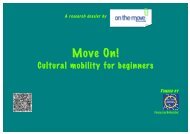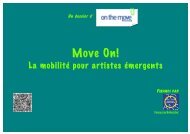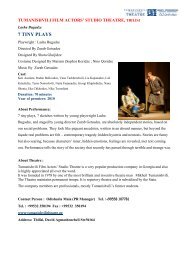DOWNLOAD Excited Atoms - On the Move
DOWNLOAD Excited Atoms - On the Move
DOWNLOAD Excited Atoms - On the Move
Create successful ePaper yourself
Turn your PDF publications into a flip-book with our unique Google optimized e-Paper software.
After each networked performance I feel <strong>the</strong> very strong wish to do something very, very solitary. Because I find<br />
virtual networking emotionally quite consuming.<br />
Susanne Berkenheger<br />
interdisciplinary_transdisciplinary<br />
Many artists and companies working in this area do not identify with ‘traditional’ artform disciplines.<br />
This is increasingly <strong>the</strong> case across all arts disciplines and responsive funding programmes and policy<br />
reflect <strong>the</strong> contemporary artistic reality.<br />
In some countries and regions, falling between designated funding areas can mean that such work is<br />
not eligible for subsidy and more traditional forms are favoured. However, it may also present<br />
opportunities and can mean that artists and companies have enormous flexibility in how and where<br />
<strong>the</strong>y present and position <strong>the</strong>mselves, enabling <strong>the</strong>m to reach multiple audiences, enjoy acclaim in<br />
different fields and be strategic in how <strong>the</strong>y engage with policy and debate. Defying conventional<br />
artform categories can lead to greater visibility and an enlarged action radius.<br />
For example, <strong>the</strong> UK-based Blast Theory’s work is presented as interactive <strong>the</strong>atre in <strong>the</strong> British<br />
Council’s connected showcase in <strong>the</strong> Tokyo Performing Arts Market, is exhibited in world<br />
contemporary art museums, art fairs and biennales; it has won a major new media award (Prix Ars<br />
Electronica), a US game developer award (Maverick Award) and been nominated for four national<br />
BAFTA <strong>the</strong>atre awards. The company performs on traditional stages and in <strong>the</strong> streets (and spaces<br />
in between); Blast Theory artists receive regular invitations to collaborate with television and radio;<br />
have curated a video programme at Tate Modern; take <strong>the</strong> lead in science-art research projects; and<br />
contribute to academic publications and teaching.<br />
Transdisciplinarity is a recurrent <strong>the</strong>me, describing how virtual mobility work can benefit from<br />
opportunities to collaborate with o<strong>the</strong>r non-arts disciplines:<br />
We are exploring types of learning and body perception <strong>the</strong>rapy in interactive virtual environments. Today we<br />
know: virtual environments are comparable to completely new instruments. They can be used for <strong>the</strong><br />
exploration, testing and learning of new body languages, <strong>the</strong> interrelationship of movements and mental<br />
connections. It is a place where highly complex and trans-disciplinary relationships between art, technology<br />
(body) perception, psychology and trans-local identity as well as physical presence and re-presence come<br />
about.<br />
Klaus Nicolai<br />
In some countries, university media research labs and arts-science programmes have provided<br />
opportunities for transdisciplinary collaboration. <strong>On</strong>e of <strong>the</strong> biggest use of telematics worldwide is<br />
in medicine, for realtime skills transfer of top global experts in complex surgical operations, and <strong>the</strong><br />
use of virtual environments in medical training is now compulsory (you train on <strong>the</strong> virtual body<br />
before you are allowed to do it on <strong>the</strong> real body!!). In many cases <strong>the</strong> interactive performing arts<br />
can benefit from research and development already done in o<strong>the</strong>r fields.<br />
participation and audiences<br />
There is a growing awareness of <strong>the</strong> one-way form of virtual mobility: streaming live performance to<br />
remote venues, mostly cinemas, where an audience in ano<strong>the</strong>r place, town, country or continent<br />
excited atoms/<strong>On</strong>-<strong>the</strong>-<strong>Move</strong>.org mobility dossier/author: Judith Staines Page 21



